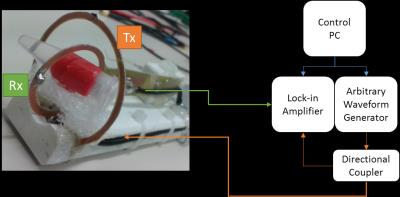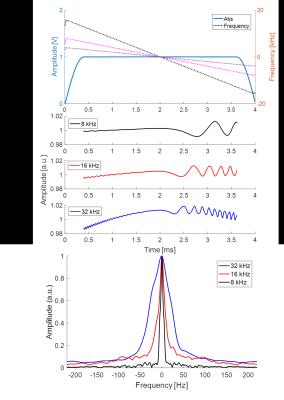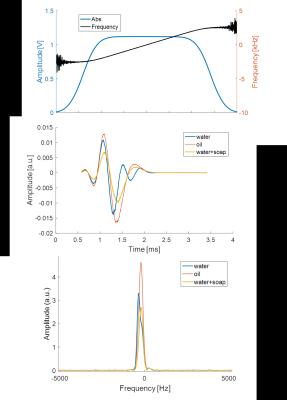5593
Full Digital Cancellation-based NMR with Concurrent Excitation and Acquisition using a Lock-in Amplifier1Deptartment of Radiology, Medical Physics, Medical Center – University of Freiburg, Freiburg, Germany, 2Institute of Microstructure Technology, Karlsruhe Institute of Technology, Karlsruhe, Germany
Synopsis
Concurrent Excitation and Acquisition (CEA) offers fundamental advantages for NMR such as 100% signal acquisition efficiency, true zero echo time, reduction of acoustic noise, and decreased peak RF power. Bandwidth of the excitation in CEA is independent of the RF power, allowing detection very broad resonances. In this work, a CEA system is introduced with a full digital cancellation. The system uses a lock-in amplifier combined with an arbitrary signal generator. Preliminary results for NMR of various samples are represented and discussed.
Introduction
MRI with concurrent excitation and acquisition (CEA) offers solutions to fundamental problems in NMR and MRI such as unwanted acquisition delays due to time-interleaved operation of Tx and Rx, acoustic gradient noise, and RF induced heating by simultaneous function of transmit (Tx) and receive (Rx) elements [1]–[5]. With CEA a 100% acquisition efficiency is possible, and measurements with true zero echo time can be achieved. Moreover, RF peak powers are in mW range, which is several orders of magnitude less than conventional MRI sequences. Previous CEA methods are based on destructive field interference, magnetic field decoupling, or analog cancellation used in full duplex radio transmission.
In this work, isolation of Tx and Rx was realized fully in digital domain using a multi-channel ultra-high frequency lock-in amplifier (UHFLI) and an arbitrary waveform generator (AWG). This method is referred to as D-CEA. Performance of D-CEA was evaluated, and proof-of-principle measurements are presented.
Methods
D-CEA experiments were conducted on a pre-clinical 1 T cryogen-free MRI system (ICON, Bruker). Tx and Rx signals were generated and processed by an UHFLI from Zurich Instruments. Two RF loop resonators of 50 mm and 35 mm diameters were built on a semi-flexible printed circuit board (35 μm copper, FR4) as Tx and Rx coils, respectively. An AWG embedded in the UHFLI was used to generate frequency-swept RF excitation pulses. A schematic of the system setup is shown in Fig.1. An asymmetric power divider was used to tap a small copy of the Tx signal to another input channel. Rx coil output was also connected to an input channel. The reference frequency used for the demodulation of both Rx and the tapped Tx signals was generated by the UHFLI. This reference was adjusted manually using the spectrometer.
Sampling and demodulation of the data was performed at 1.8 Gs/sec. After demodulation and low-pass filtering the signals were down-sampled at 430 ks/sec.
First, a plastic bulb filled with tap water was placed in the coil setup, and chirp (i.e. with smooth edges) RF pulses of 7 dBm with sweep rates 8, 16, 32 kHz/4ms was applied (Fig.2). Two sample tubes filled with herbal oil and water and liquid soap mixture were also measured using a hyperbolic-secant (HS4) RF waveform with 6 kHz/4ms (Fig.3). The resonance spectra were calculated by deconvolving the measured signal with the RF pulse [6]. Digital subtraction of Tx-induced leakage was based on the tapped Tx signal. A phase correction was applied to align phases of reference and the Rx signals. After leakage subtraction, a Butterworth filter of 13th order was applied to the raw data. Zero-padding, and apodization using a Gaussian function was applied before Fourier transformation.
Results and Discussion
In Fig.2, unprocessed raw data and the resonance spectrum calculated for different frequency sweep rates are shown. The shape of the rapid-scan signal is strongly dependent on the scan rate, and oscillations due to Tx source imperfections are visible in the data. SNR for 8, 16, and 32 kHz sweeps are calculated as 372, 207, 429, respectively. Systematic distortions can be eliminated by averaging, and baseline drifts can be decreased by increasing the receive bandwidth.
The HS4 RF pulse covered an effective bandwidth of 6 kHz (Fig.3). The calculated spectra show a 145.5 Hz difference (3.5 ppm) between the water and oil resonance peaks.
NMR with CEA was shown to be feasible using full digital cancellation with an UHFLI. D-CEA system eliminates the effects of loading and Tx stability factors, which are the major problems of analog cancellation systems. Further investigations with more complex samples are necessary to compare performance of CEA and pulsed experiments. Application of CEA in samples with extremely broad lines such as proteins is a potential research area.
Similar to this work in Electron Spin Resonance (EPR) an analog cancellation by including a third arbitrary wave generator was introduced [8] . Our system however implements the same functions with a simpler setup and it is applicable to all existing MR systems independent of the field strength and the RF resonator.
Acknowledgements
DFG grants HA 7006/1-1 and BO 3025/8-1 are gratefully acknowledged.References
[1] A. C. Özen, M. Bock, and E. Atalar, “Active decoupling of RF coils using a transmit array system,” Magn. Reson. Mater. Physics, Biol. Med., 2015.
[2] D. Idiyatullin, S. Suddarth, C. Corum, G. Adriany, and M. Garwood, “Continuous {SWIFT},” J. Magn. Reson., 2012.
[3] S.-M. Sohn, J. T. Vaughan, R. L. Lagore, M. Garwood, and D. Idiyatullin, “In vivo MR imaging with simultaneous RF transmission and reception,” Magn. Reson. Med., vol. 0, pp. 1–7, Sep. 2016.
[4] A. C. Özen, E. Atalar, J. Korvink, and M. Bock, “In vivo Concurrent Excitation and Acquisition MRI with Self-referenced Active Decoupling,” in 24th Scientific Meeting, International Society of Magnetic Resonance in Medicine, 2016, p. 2179.
[5] M. Salim, A. C. Özen, M. Bock, and E. Atalar, “Detection of MR Signal during RF Excitation using Full-Duplex Radio System,” in 24th Scientific Meeting, International Society of Magnetic Resonance in Medicine, 2016, p. 3636.
[6] P. S. Belton, “Chapter 17 Continuous wave and rapid scan correlation NMR,” in Signal Treatment and Signal Analysis in NMR, D. N. Ruthledge, Ed. Elsevier, 1996, pp. 362–373.
[7] K. J. Layton, B. Tahayori, I. M. Y. Mareels, P. M. Farrell, and L. A. Johnston, “Rabi resonance in spin systems?: Theory and experiment,” J. Magn. Reson., vol. 242, pp. 136–142, 2014.
[8] M. Tseitlin, R. W. Quine, G. A. Rinard, S. S. Eaton, and G. R. Eaton, “Digital EPR with an arbitrary waveform generator and direct detection at the carrier frequency,” J. Magn. Reson., Sep. 2011.
Figures


